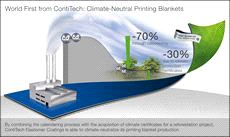Consumables
Environmental Technology in Action at ContiTech: CONTI-AIR Brand Printing Blankets

Monday 03. May 2010 - CONTI-AIR printing blankets with the PURE PRINTING label protect the environment Innovative production process reduces CO2 emissions Investment in climate certificates New measuring device increases reliability of printing process
ContiTech Elastomer Coatings is the first manufacturer anywhere in the world to climate-neutralize its printing blanket production. A new kind of manufacturing process eliminates up to 70% of the climate-damaging CO2 emissions released in the production of world standard printing blankets. The company offsets the residual CO2 emissions by supporting a reforestation project in Panama, for which it acquires climate protection certificates.
ContiTech Elastomer Coatings carries the climate-neutral printing blankets in its CONTI-AIR HC line-up under the PURE PRINTING label. “These printing blankets improve the printing processs carbon footprint and easily satisfy our customers ever more pressing ecological demands,” says Dr. Thomas Perkovi?, head of the printing blanket segment at ContiTech Elastomer Coatings. “By assuming a climate-neutral stance, we have bolstered our leadership position in the printing blanket domain in terms of innovative environment and climate protection solutions and are proud to be the worlds first manufacturer marketing climate-neutral printing blankets. We are thus able, in this major way, to contribute to environmentally sound printing. And this is achieved at no extra cost to our customers.”
Enhanced climate protection thanks to calendering technology
The calendering process used by ContiTech Elastomer Coatings to make the printing blankets is chiefly responsible for the CONTI-AIR HC lines small carbon footprint. In this process, a steel roller forms the rubber into a slab, which is a much more energy-efficient approach than the conventional coating process. What is more, solvent additives can be dispensed with, so VOC (volatile organic compound) emissions are greatly reduced.
The calendering processs favorable carbon footprint was determined in the summer of 2009. ContiTech Elastomer Coatings became the first manufacturer anywhere in the world to have its printing blankets assessed and certified for their climatic impact, in this case by the Ostwestfalen-Lippe University of Applied Sciences. It was found that 70% fewer emissions are emitted in producing CONTI-AIR HC line printing blankets than in the conventional manufacturing process for world standard printing blankets. “As good as these values already are, we go a step farther, because we want to offer our customers climate-neutral printing blankets,” explains Dr. Perkovi?. “That is why we opted to acquire climate protection certificates as a means of neutralizing the remaining CO2 emissions.”
Reforestation project in Panama
To neutralize the remaining CO2 emissions, ContiTech acquired climate certificates from natureOffice (www.natureoffice.com), a climate protection agency. In so doing, ContiTech supports a reforestation project in Panama that benefits not only nature but also those living in an economically underdeveloped region. Planting trees creates a tropical forest that pulls carbon dioxide out of the atmosphere and releases oxygen. At the same time it protects the groundwater, prevents soil erosion and offers a habitat for rare fauna and flora. Long-term jobs with social benefits are, moreover, also created for the people in the area and their lives improved, not least of all by making microloans available to them.
Competent cooperation
In addition, ContiTech Elastomer Coatings together with the Swedish company NIP CONTROL is presenting a world first – a system capable of measuring compressibility in the nip zone between the plate and rubber blanket cylinder in offset printing. This digital pressure indicator measures the maximum force in Newton per square centimeter at the printing nip between the cylinders, thus enabling the printer to adjust the printing process more reliably. So far there has only been an indirect method by which the height of the rubber blanket or the printing plate could be measured, which meant that the compressibility of the rubber blanket was not taken into consideration.
